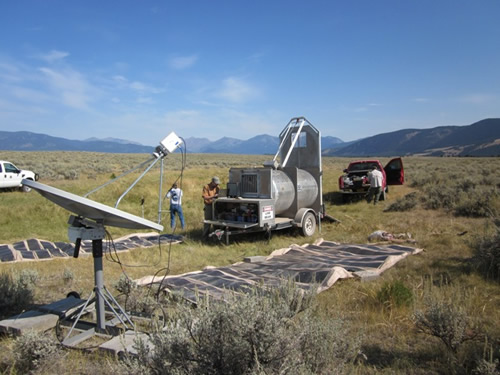
The technological bear trap being set up
Technology Added to Bear Management
By Larry Hyslop

The technological bear trap being set up
Tim Manley is a Grizzly Bear Management Specialist with the Montana Fish, Wildlife and Parks Department (FWP). He spends many hours in his pickup, driving to spots where he conducts research or removes problem bears from people’s back yards and bee hives. This work requires long hours since these bear traps must be checked daily and are usually empty.
But last summer, during a 72 day long study in the Swan Valley, he used the department’s new Automated Bear Trap (ABT). When something entered the trap and the door closed, the ABT sent him an email, using a cell phone when within cell phone coverage. When the trap was set up out of range, a satellite dish was erected near the trap so the email came through the Internet. Storage batteries and solar panels powered the ABT.
Tim could then check the trap contents using either visible light or infrared cameras. If the trap contained an unwanted bear or something other than a bear, Tim simply sent a command to the ABT to open the door and release the animal. If the bait was still good, the trap could again be set. Only if the trap contained a bear he wanted, did he travel to the trap site.
On warm summer days, the temperature inside the trap can become hot enough to endanger the bear, so the ABT has temperature sensors. If they pass a certain temperature, another email is sent. If Tim determines the trap to be too hot, he can release the bear.
The ABT also gives him some options when releasing a bear, either where it was trapped or at a new site. Rather than simply open the door and release a fairly agitated bear, he can program the door to open later, in the middle of the night.
The trap’s door carries a sign reading “Door may open without warning.” Sage advice to the curious hiker who might approach the trap about the time Tim decides to release an exceedingly annoyed and trapped bear. He posts signs around the site, containing web cam images of trapped bears, so curious people have an idea what might be waiting inside it.
Bear managers and researchers insert microchips beneath the skin of bears, to identify them much as we do our pets. Such microchips are replacing ear tags. The ABT also has a microchip reader that can send yet another email so Tim can identify the bear. The reader can even sense microchips of bears that do not enter the trap but simply wander past.
“It works well, and saved me a lot of time and money,” Tim told me. The ABT is a prototype donated to the FWP department by Alter Enterprises. This Missoula company will soon offer such traps to other wildlife departments. During the Swan Valley study, Tim estimates it saved him 150 hours of his work time and $5,000 in travel, since the trap sites were a long drive from Tim’s Kalispell office. At a recent bear management seminar, 300 bear managers from around the world were very interested in the displayed ABT.
Elko Daily Free Press, “Nature Notes”, 4/12/2012
© Gray Jay Press, Elko, NV
Return to Elko Nature Notes